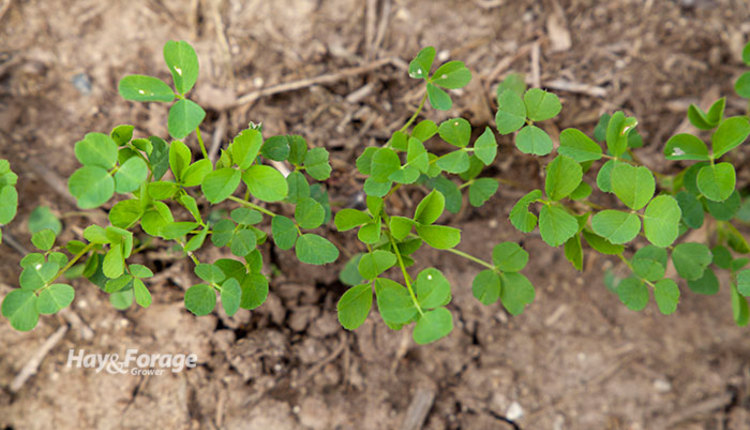Seize late-summer seeding opportunities |
| By Amber Friedrichsen, Associate Editor |
|
|
 As the days get shorter and the end of summer draws near, some producers may be gearing up to seed new perennial forage stands. That said, seeding method, timing, and weed control will contribute to seedling establishment and stand persistence over the winter and into the next few years. In a recent C.O.R.N. Newsletter from Ohio State University Extension, Mark Sulc notes that the biggest threat to late-summer seedings is inadequate moisture. The extension forage specialist recommends assessing soil conditions in each individual field and forecasting precipitation to determine if seeding a new stand right now will be successful. New seedings No-till seeding may be beneficial to conserve soil moisture, but field surfaces might not be as smooth as they would be with conventional tillage. Plant pathogens are also more prevalent in no-till seedings, especially in fields with a history of clover. Sclerotinia crown and stem rot can affect alfalfa and red clover when temperatures cool, so it is critical to initiate no-till seedings sooner rather than later. “Early August planting dramatically improves alfalfa’s ability to resist or tolerate the disease infection,” the extension forage specialist states. “Late August or early September seedings are very susceptible to the disease, with mid-August plantings being intermediate.” No-till seedings may experience greater weed pressure as well. Sulc suggests applying glyphosate before planting, but if resistant species like marestail are problematic, conventional tillage might be necessary. “Be aware that too much tillage depletes soil moisture and increases the risk of soil crusting,” Sulc cautions. “Follow the footprint guide: Soil should be firm enough for a footprint to sink no deeper than 1/2 inch. Tilled seedbeds usually do not need a preplant herbicide,” he adds. Reseeding In addition to planting new forage stands, it is also a good time to fill gaps in 2022 spring seedings. Alfalfa can even be drilled into thin areas of an existing stand because alfalfa autotoxicity won’t be strong enough to impede establishment. “Alfalfa plants that are less than a year old do not release enough autotoxic compounds into the surrounding soil to harm new seedlings,” Sulc says. “This summer is the last opportunity to try to patch thin areas of alfalfa stands that were seeded this spring. By next spring, autotoxicity will be a concern.” Administer herbicide before reseeding. “Consider applying a grass herbicide to pure legume stands or a broadleaf herbicide in pure grass stands,” Sulc says. “If broadleaf weeds are present in legume stands or mixed grass-legume stands, options are much more limited because most broadleaf herbicides labeled for use in alfalfa or other legume forages are only effective when the weeds are quite small.” Follow product label instructions, and only use herbicides that require little to no waiting period between application and seeding. Then, cut existing forage and immediately drill seed, preferably before a rainfall event. If weeds persist, apply a postemergence herbicide in mid- to late fall. Other variables Regardless of the reason for seeding, ensure soil pH and fertility are sufficient. The optimal pH for alfalfa is between 6.5 and 6.8, whereas other forage clovers and grass species need a pH of 6 or higher. Choose high-quality seeds of forage species that are adapted to the growing environment. Seed coating can account for as much as one-third of the weight of seed, so be sure to adjust planting rates accordingly. Moreover, plant seeds 1/4 to 1/2 inch deep for proper establishment. “Do not harvest a new perennial forage stand this fall,” Sulc asserts. “The only exception to this rule is perennial and Italian ryegrass plantings. Mow or harvest these grasses to a stubble height of 2.5 to 3 inches in late November to improve winter survival.”  Amber Friedrichsen Amber Friedrichsen is the 2022 Hay & Forage Grower editorial intern. She currently attends Iowa State University where she is majoring in agriculture and life sciences education-communications and agronomy. Friedrichsen grew up on her family’s diversified crop and livestock farm near Clinton, Iowa.
|
